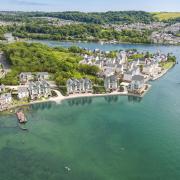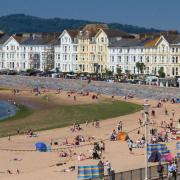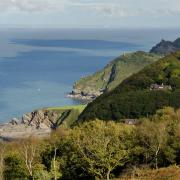During the summer more than 5,000 yachts and other river users will visit Salcombe. Enthusiasts of all descriptions, from yachtsmen to dinghy sailors from the owners of large power boats to small inflatable craft ply the sheltered waters. Managing...
During the summer more than 5,000 yachts and other river users will visit Salcombe, keeping the Harbourmaster and his team busy. Robert Hesketh finds out just what the job involves.
With its wooded slopes, sandy beaches and secluded creeks the Kingsbridge Estuary is one of the most beautiful places in Devon. Nutrient-rich tides and an exceptionally mild climate ensure an abundance of marine and bird life.
The estuary, a superb natural harbour, and the town of Salcombe on its western bank, are immensely popular with local and visiting sailors. Enthusiasts of all descriptions, from yachtsmen to dinghy sailors, from the owners of large power boats to small inflatable craft ply the sheltered waters. Shellfishing boats, ferries, hire and charter boats all add to the busy traffic.
Managing and conserving the harbour and estuary, with its quays, slipways, pontoons, moorings, Site of Special Scientific Interest and many boats, and balancing the interests of tourism, leisure, fishing and wildlife, is the responsibility of Salcombe Harbour Authority. Keeping everything running smoothly and safely is a demanding job, especially in the busy summer season.
Commander Ian Gibson, Salcombe's Harbourmaster, explained: "Summer is about making the harbour safe and accessible. The season runs from Easter, but really kicks off at Whitsun. Most of my staff don't take any summer holiday. July and August are incredibly busy. Last year, for instance, we had 5,500 visiting yachts during the three peak months.
"The estuary at its best during the shoulder months, when the weather's good and you can enjoy the beauty and tranquillity of the estuary. To encourage visitors during April, May and September we offer a 25% reduction on mooring charges. I know Salcombe has an expensive reputation, which is why we've pegged the price of moorings for visiting yachts for the last three years.
"We have 12 permanent staff. Bruce Harding's in charge of Moorings; Vanessa Tabb is Assistant Harbourmaster for Administration, and Raymond Rowe and his team take care of Logistics and Maintenance."
Ian has a wide skills base to draw on. Together, his team have valuable experience in many fields, including the Royal Navy (Ian himself served for 32 years), Salcombe Lifeboat, commercial fishing, the Fire Brigade and yachting.
During the summer Ian takes on another dozen staff. Two people manage Batson Boat Park and slipway. Four water taxi drivers work in shifts from 8am to 11pm, helping people to and from their boats. This cuts down on the number of tenders that have to tie up.
The Duty Boatman is Ian's daily representative on the water, making sure everything's running safely and smoothly, with people mooring in the right places. He also ensures the rubbish is taken away from the pontoons and recycled: "Last year we achieved a 40% recycling rate."
Three collectors work alongside the Duty Boatman to collect boat and harbour dues. Two more people work on the town pontoons during July and August, helping tenders berth and keeping the pontoons clear for boats to land and pick up passengers.
Improving access from water to land is one of the team's big challenges. "When the tide goes out, a lot of mud is exposed, drastically reducing alongside berthing. There are three main landing points. We've put a new pontoon in at Batson this year to improve access from the slipway. It's purely for launching and recovery, so no berthing is allowed there or on the front of Whitestrand Pontoon. It's very important to maintain access to the town and Batson. If people ignore all the signs and tie up where they shouldn't, we'll tow their boat away - the nautical equivalent of wheel clamping!"
Normandy Pontoon is reserved for visiting yachtsmen. It was named in honour of the troops who embarked here for D-Day in 1944, and there's a commemoration every 4 June which is well attended by veterans.
Salcombe is blessed with beautiful sandy beaches, including North and South Sands and more on the East Portlemouth side. "This is the jewel in our crown," Ian says. "Other harbours have nothing comparable. However, this brings its own problems. Many people visit the beaches and they often go by boat.
"In summer we have a huge volume of traffic, thousands of boat movements in and around the harbour. We have the problem of finding berths for them and maintaining access, whilst ensuring they move safely and allow for the strong tidal currents - which catch a lot of people out.
"Any activity on the water is potentially dangerous. Managing a harbour is all about risk management. Following the Port Marine Safety Code, we have to tread a line between helping people enjoy the estuary without being too regulatory and maintaining safety, which is always our number one priority."
"Salcombe has a Tamar Class all-weather Lifeboat stationed permanently here," added Moorings Officer Bruce Harding, "and they've also got a fast inshore rescue boat. We work in conjunction with the Lifeboat service, the Coastguard and the Fire Brigade. We have regular training in fire fighting, first aid, health and safety, plus a wide range of other skills, such as driving the crane and the forklift truck, so we can all multi-task."
"One of our measures for dealing with the boat traffic problem is modifying the byelaws to reduce the speed limit," continued Ian. "We aim to keep the general speed limit to eight knots, but reduce it to six from the Marine Hotel to the Salt Stone, where traffic is densest. This will reduce wash - small boats are very vulnerable to wash - and reduce the impact of any collisions that might occur. We advocate everyone proceeds at a safe speed - and what that is depends on several factors, including depth of water, weather conditions and density of traffic."
Salcombe is a premier sailing destination, so traffic is dense. It's a nice day-sail from Torbay, Dartmouth or the Yealm and yachts also come from Cornwall, along the South Coast and neighbouring ports in France, Holland and Germany. Salcombe Yacht Club are very active in racing dinghies and host a series of open events throughout the year, including the Merlin Rockets, the National Twelves, the Hornet Weekend, the Wanderers and a regatta in August. Hundreds of racing dinghies come from all over the country. "At a race start we sometimes have over 200 sailing boats in the main estuary, so we keep a fairway free of racing dinghies for powerboats to enter and leave.
"Our busiest times are the Regatta weeks, running back to back," Ian says. "They're long days, starting at 6am and finishing at 11pm and take all my staff. Salcombe Town Regatta will be from 4-8 August this year, followed by the Salcombe Yacht Club Regatta, 10-15 August. This year, we've got the Red Arrows for the first time. They'll fly on 9 August.
In the winter season, beginning in October, the team maintains its regular service, but focuses on maintenance and preparing for the next season. "We have 350 deep-water moorings and each one of those has to be lifted to the surface and inspected. A diver has to disconnect and reconnect the moorings. Any worn parts are replaced."
"Moorings have to be completely clear for the divers," explained Bruce Harding. "Last year we completed the job in 21 working days, but we had unusually good weather. Near Christmas we remove all the pontoons and bridges for maintenance and to prolong their lives we put them up in the creeks out of the way. After that comes the foreshore work, which has to be planned around the tides. We have 650 foreshore moorings - and each is inspected every winter. It's very hard work wading through the soft mud with your maintenance tools!"
"We don't have any marinas and large areas of the estuary are kept free of moorings," continued Ian. "It's the policy of the Harbour Board not to over develop the estuary and keep it as a wildlife haven. The Board's vision is to provide 21st-century facilities without changing the character of the estuary. That's a challenge my whole team have worked extremely hard to meet, whilst improving facilities in Salcombe Harbour and the services we offer. The most satisfying thing about our job is when people come into the office and say that they really enjoyed their visit."
Ian Gibson's Tips for Safer Sailing
Wear a life jacket. ("You never know when you might be tipped overboard")
Follow the 'Rules of the Road'
Observe the speed limit
Don't underestimate the tide
Be considerate to other harbour users
FURTHER INFORMATION:
For more information telephone the Harbour Office on (01548 843791 (emergency out of hours (01803 867034). Email salcombe.harbour@southhams.gov.uk or visit www.salcombeharbour.co.uk


























